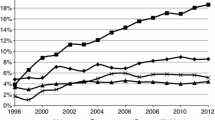Abstract
The purpose of this study is to analyze the cost structure of a sample of Italian wastecollection firms in order to assess economies of scale and density and, therefore, definethe optimal size of the firms. A total and a variable translog cost function were estimated using panel data for a sample of 30 firms operating at the provincial level over the period 1991–1995.
The empirical evidence suggests that franchised monopoly, rather than side-by-sidecompetition, is the most efficient form of production organization in the waste collection industry. Further, the majority of firms are not operating at optimal scale.
Similar content being viewed by others
References
Antonioli, B., Fazioli, and M. Filippini (2000) ‘Analisi dei rendimenti di scala per il servizio di igiene urbana in Italia’, in Economie delle fonti dell'Energia e dell'ambiente, n. 2.
Barten, A. P. (1969) ‘Maximum Likelihood Estimation of a Complete System of Demand Equations’, European Economic Review, 1, 25–29.
Caves, W. C., L. R. Christensen, and M. W. Tretheway (1984) Economies of Density versus Economies of Scale: Why Trunk and Local Service Airline Costs Differ, Rand Journal of Economics, 15, 471–489.
Christensen, L. R., and W. H. Greene (1976) ‘Economies of Scale in U.S. Electric Power Generation’, Journal of Political Economy, 84, 665–675.
CISPEL (1997) Annuario Ufficiale Economico-Statistico.
Cornes, R. (1992) Duality and Modern Economics. Cambridge: Cambridge University Press.
Filippini, M. (1998) ‘Are Municipal Electricity Distribution Utilities Natural Monopolies?’, Annals of Public and Cooperative Economics, 2, 157–174.
Filippini, M., and R. Maggi (1993) ‘Efficiency and Regulation in the Case of the Swiss Private Railways’, Journal of Regulatory Economics 5, 199–216.
Friedlaender, A. F., and J. Shaw-Er Wang Chiang (1983) ‘Productivity Growth in the Regulated Trucking Industry’, Research in Transportation and Economics, 1, 149–184.
Sbandati, A., and S. Cima (1999) L'economia dei rifiuti solidi urbani, Franco Angeli
Stevens, B. J. (1977) ‘Scale, Market Structure, and the Cost of Waste Collection’, The Review of Economics and Statistic, 60, 438–448.
Tickner, G., and J. McDavid (1986) ‘Effects of Scale and Market Structure on the Costs of Residential Solid Waste Collection in Canadian Cities’, Public Finance Quarterly, 14, 371–391.
Zellner, A. (1962) ‘An Efficient Method of Estimating Seemingly Unrelated Regressions and Test for Aggregation Bias’, Journal of the American Statistical Association, 58, 348–368.
Author information
Authors and Affiliations
Rights and permissions
About this article
Cite this article
Antonioli, B., Filippini, M. Optimal Size in the Waste Collection Sector. Review of Industrial Organization 20, 239–252 (2002). https://doi.org/10.1023/A:1015043524679
Issue Date:
DOI: https://doi.org/10.1023/A:1015043524679




